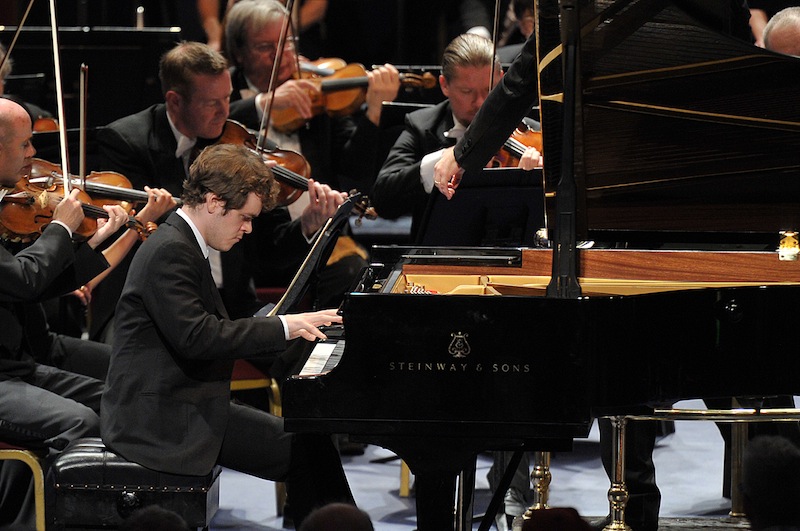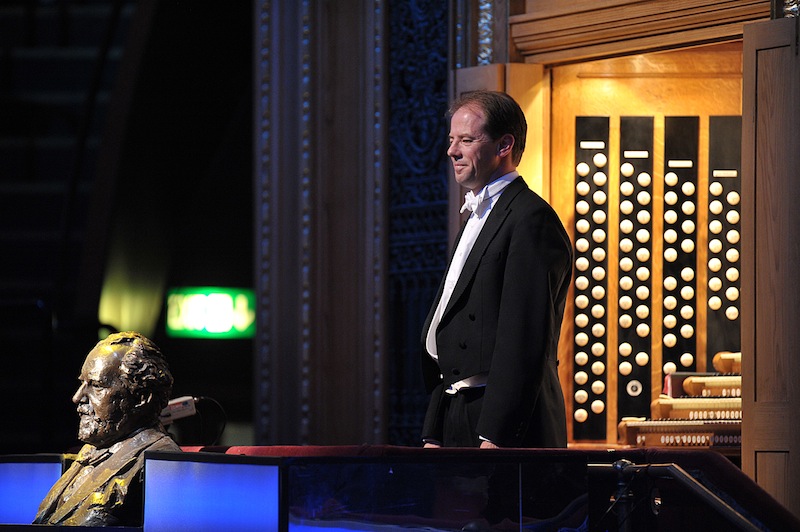Prom 29: Grosvenor, Goode, BBC Philharmonic, Noseda | reviews, news & interviews
Prom 29: Grosvenor, Goode, BBC Philharmonic, Noseda
Prom 29: Grosvenor, Goode, BBC Philharmonic, Noseda
Disappointing Chopin, but an Italian rarity and the Royal Albert Hall organ offer honey and fire
“That,” she said, “is what it must be like when you enter heaven.” And I knew just what my wife meant. The organ was in full regalia, revelling in the marshmallow glory of the chorale theme in Saint-Saëns’ Third Symphony, with the orchestra trumpeting behind. The Royal Albert Hall itself proved pretty impressive, even when the gentleman in the row in front spent most of Franck’s Symphonic Variations eating a tub of ice cream.
Well, almost everything. You couldn’t say that volleys of applause followed Noseda’s first offering – the long-delayed Proms premiere of Alfredo Casella’s Elegia eroica, an abrasive, shape-shifting memorial to the Italian dead of the First World War, composed in 1916. But it was still a fascinating 15 minutes, twisting kaleidoscopically from its ominous opening of dissonant horns, snarling timpani and aggressively trilling strings to the consoling coda with celesta and solo flute. One of Noseda’s missions in life has been to widen the world’s knowledge of Italian composers of the 20th century (early to mid), and his old orchestra piled into this colourful chunk of the protean Casella with admirable verve and dedication.

Though somehow not always in Chopin, a composer who’s caused him in the past to skate around beautifully (oh, those filigree decorations) without ever quite reaching the music’s soul. And so it was here. Head soberly regarding the keys, his fingering always stayed elegantly tidy and his tone clean. But the piano playing seemed too tightly tailored to reach far across the Royal Albert Hall, even when Noseda’s arms gave their customary impression of planes coming into land. The audience positively bathed Grosvenor in hot applause, though one wonders if some weren’t applauding his fame and age rather than his actual performance.
Happily, Grosvenor communicated more emotion and pleasure when playing the wriggling caterpillar that is Franck’s Symphonic Variations. Franck is a composer who usually gives me an upset stomach, but even that didn’t stop me appreciating the virtuoso diamonds Grosvenor scattered among the theme mutations and rippling harmonies. Even better were those moments when the pace slowed and textures thinned to the piano’s solo line, each sound poetically shaped. You could hear the hall hanging on every note. Here, the applause was justified.

Above all, there are the work’s core strengths: its memorable tunes, its structural subtleties, and fine contrasts between rapturous clamour and quieter moments of dancing clarity and surprise. The sound balance of this performance was just right, with the organ something to relish even when serving as a taste of honey or a gentle embrace. Noseda and the Philharmonic had their glories too as the orchestra delicately fragmented to reveal four hands at a piano tinkling alongside singing strings. At such moments there was only one word for it: heavenly.
rating
Explore topics
Share this article
The future of Arts Journalism
You can stop theartsdesk.com closing!
We urgently need financing to survive. Our fundraising drive has thus far raised £49,000 but we need to reach £100,000 or we will be forced to close. Please contribute here: https://gofund.me/c3f6033d
And if you can forward this information to anyone who might assist, we’d be grateful.

Subscribe to theartsdesk.com
Thank you for continuing to read our work on theartsdesk.com. For unlimited access to every article in its entirety, including our archive of more than 15,000 pieces, we're asking for £5 per month or £40 per year. We feel it's a very good deal, and hope you do too.
To take a subscription now simply click here.
And if you're looking for that extra gift for a friend or family member, why not treat them to a theartsdesk.com gift subscription?
more Classical music
 Echo Vocal Ensemble, Latto, Union Chapel review - eclectic choral programme garlanded with dance
Beautiful singing at the heart of an imaginative and stylistically varied concert
Echo Vocal Ensemble, Latto, Union Chapel review - eclectic choral programme garlanded with dance
Beautiful singing at the heart of an imaginative and stylistically varied concert
 Scott, Irish Baroque Orchestra, Whelan, RIAM, Dublin review - towards a Mozart masterpiece
Characteristic joy and enlightenment from this team, but a valveless horn brings problems
Scott, Irish Baroque Orchestra, Whelan, RIAM, Dublin review - towards a Mozart masterpiece
Characteristic joy and enlightenment from this team, but a valveless horn brings problems
 Classical CDs: Voice flutes, flugelhorns and froth
Baroque sonatas, English orchestral music and an emotionally-charged vocal recital
Classical CDs: Voice flutes, flugelhorns and froth
Baroque sonatas, English orchestral music and an emotionally-charged vocal recital
 Kanneh-Mason, Britten Sinfonia, Shave, Milton Court - a grin and a big beaming smile
A pair of striking contemporary pieces alongside two old favourites
Kanneh-Mason, Britten Sinfonia, Shave, Milton Court - a grin and a big beaming smile
A pair of striking contemporary pieces alongside two old favourites
 theartsdesk at the New Ross Piano Festival - Finghin Collins’ musical rainbow
From revelatory Bach played with astounding maturity by a 22 year old to four-hand jazz
theartsdesk at the New Ross Piano Festival - Finghin Collins’ musical rainbow
From revelatory Bach played with astounding maturity by a 22 year old to four-hand jazz
 First Person: Manchester Camerata's Head of Artistic Planning Clara Marshall Cawley on questioning the status quo
Five days of free events with all sorts of audiences around Manchester starts tomorrow
First Person: Manchester Camerata's Head of Artistic Planning Clara Marshall Cawley on questioning the status quo
Five days of free events with all sorts of audiences around Manchester starts tomorrow
 Goldscheider, Brother Tree Sound, Kings Place review - music of hope from a young composer
Unusual combination of horn, strings and electronics makes for some intriguing listening
Goldscheider, Brother Tree Sound, Kings Place review - music of hope from a young composer
Unusual combination of horn, strings and electronics makes for some intriguing listening
 theartsdesk Q&A: composer Donghoon Shin on his new concerto for pianist Seong-Jin Cho
Classical music makes its debut at London's K-Music Festival
theartsdesk Q&A: composer Donghoon Shin on his new concerto for pianist Seong-Jin Cho
Classical music makes its debut at London's K-Music Festival
 Helleur-Simcock, Hallé, Wong, Bridgewater Hall, Manchester review - moving lyricism in Elgar’s concerto
Season opener brings lyrical beauty, crisp confidence and a proper Romantic wallow
Helleur-Simcock, Hallé, Wong, Bridgewater Hall, Manchester review - moving lyricism in Elgar’s concerto
Season opener brings lyrical beauty, crisp confidence and a proper Romantic wallow
 Kohout, Spence, Braun, Manchester Camerata, Huth, RNCM, Manchester review - joy, insight, imagination and unanimity
Celebration of the past with stars of the future at the Royal Northern College
Kohout, Spence, Braun, Manchester Camerata, Huth, RNCM, Manchester review - joy, insight, imagination and unanimity
Celebration of the past with stars of the future at the Royal Northern College

Add comment